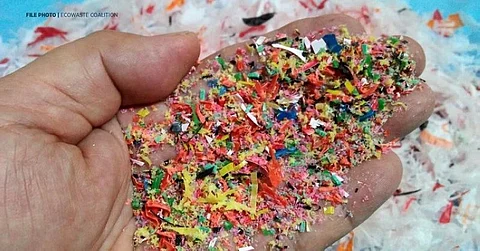

A DAVAO City-based environmental group said they are alarmed with a recent study confirming the presence of microplastics in some parts of the Philippines, including Davao Gulf.
Ecowaste Coalition revealed a report from the Coastal Resources and Ecotourism Research, Development and Extension Center (CRERDEC), confirming the presence of microplastics in the country's marine waters.
CRERDEC is a division under the Department of Environment and Natural Resource-Ecosystems Research and Development Bureau (DENR-ERDB).
The “Microplastic Contamination Determination of Selected Water Bodies in the Philippines” study of CRERDEC confirmed the presence of microplastics in Philippine waters with the Tañon Strait Protected Seascape in Badian and Moalboal, Cebu having the highest density of microplastics among the ten study areas nationwide.
Study sites and sampling points also included in the study are Manila Bay, Subic Bay, Lamon Bay, Boracay Island, Taklong Island National Marine Reserve, Tañon Strait Protected Seascape, Davao Gulf, Butuan Bay, Iligan Bay, and the special area, Apo Reef Natural Park.
Jon Alfonso P. Horvidalla, science research specialist and study leader of the project, said such research finding is alarming considering that the presence of microplastics in the study areas could have detrimental effects on the function of the marine ecosystem, particularly coral reefs.
Interfacing Development Interventions for Sustainability (Idis) Executive Director Mark Peñalver told SunStar Davao that the presence of microplastics in Davao Gulf has been a long-time problem and can be mainly attributed to improper solid waste management practices.
Peñalver said microplastics come from a variety of sources, including from larger plastic debris that degrades into smaller pieces. In addition, microbeads, a type of microplastic, are very tiny pieces of manufactured polyethylene plastic that are added as exfoliants to health and beauty products, such as some cleansers and toothpaste.
These tiny particles easily pass through water filtration systems and end up in the ocean and lakes, posing a potential threat to marine life.
He said studies showed that some marine creatures, particularly fishes, had digested microplastics. Some microplastics would eventually contaminate other bodies of water, including the sources of drinking water.
"Since these are microplastics, wala ta’y way to filter that (we don’t have a filtering mechanism for that), and eventually, it will go to the waters na ginainom nato (that we drink). This can also be digested by our water animals such as fish and crustaceans. Mubalik gihapon sa atoa ang effects sa microplastics (The effects of microplastics would go back to us),” Peñalver said.
Peñalver said they have no independent study on the possible volume of microplastics collected in the body of waters in the city or the region.
He said the CRERDEC study should serve as a call to action for both the government and the public on addressing solid waste management by minimizing or eliminating the consumption of plastics.
The Davao City Government, in June 2021, signed the “No to Single-Use Plastics Ordinance of 2021."
However, Peñalver said the implementing rules and regulations are still being crafted as of this writing.
In a report from the World Health Organization (WHO), there is insufficient information to conclude on the toxicity of plastic particles.
Studies on absorption indicate that microplastics greater than 150 micrometers are likely to be excreted directly through feces.
“Toxicology studies in rats and mice reported some impacts including inflammation of the liver. However, these few studies are of questionable reliability and relevance, with findings reported at very high exposures that would not occur in drinking-water,” WHO said in a report.